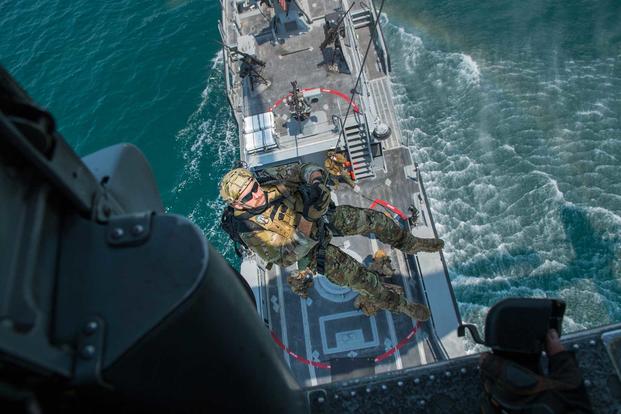After years of land-based bomb-clearing missions in the Middle East, the Navy's explosive ordnance disposal community is shifting its focus back to the sea.
It has a new 10-year plan that lays out how its 1,800-person force will support the fleet -- and entire military -- as U.S. troops face off against more powerful adversaries. The strategy was written by junior officers and senior enlisted leaders and marks the first time the force has completed a major mission update in more than two decades.
With less demand for them to clear roadside bombs and other threats in Iraq and Afghanistan, the Navy's explosive ordnance disposal experts are getting back to their roots.
Read Next: Marines Hop Islands, Set Up Long-Range Fires as Force Preps for Clash with China
"The water is our primary domain," Capt. Richard Hayes, Explosive Ordnance Disposal Group 2's commander, told reporters Thursday. "Now that we have less capacity dedicated to those land missions ... we are spending a bit more time in the maritime domain."
As the military shifts its focus toward readying for conflict with countries such as China, Russia or Iran, the Navy's EOD force will build up its underwater and cyber capabilities, said Capt. Oscar Rojas, Explosive Ordnance Disposal Group One's commodore.
That will lead to career opportunities. The strategy states that while the service's EOD enlisted force has grown in the last two decades, "our current enlisted recruiting capabilities and throughput do not meet the community's required end strength."
Rojas said growth of the EOD force is likely to continue for the next five years, primarily due to the need for expeditionary mine countermeasures. Unmanned systems platoons, which work with expeditionary mine countermeasures units, are expanding.
The Navy operates the Mk 18 Mod 1 Swordfish and Mk 18 Mod 2 Kingfish unmanned underwater vehicles, which hunt for threats that could prove deadly to troops heading ashore. The EOD force will continue leveraging unmanned platforms and robots to complete its high-stakes missions, leaders say.
"That does come with new rates that have not traditionally been part of the Navy EOD community," Rojas said, adding, "Within that unmanned systems platoon, there are some rates that ... are bringing some unique skill sets that allow us to dominate in the expeditionary undersea warfare domain."
The duty requires intelligent, adaptable and capable operators who are physically fit and can manage highly stressful situations in complex environments.
"Identifying suitable candidates proves challenging, but remains paramount to the success of the individual and the mission," the strategy states.
The strategy mentions bonuses and education opportunities to help retain personnel. While those initiatives are important, Senior Chief Petty Officer Jeff Rothrock, senior enlisted adviser for capability development with EOD Group 1, said the new strategy and return to sea are creating excitement in the community.
EOD operators tend to stay because they believe in the mission, he added, and they're motivated by seeing where things are headed.
"There has been a lot of consideration about what our future is going to look like," Rothrock said. "And when we started putting this together, as I was discussing things with my peers, we had a huge, huge response back on the excitement of getting into a new domain."
-- Gina Harkins can be reached at gina.harkins@military.com. Follow her on Twitter @ginaaharkins.
Related: Navy Looks to Pro Sports to Boost Performance of EOD Techs and Divers












